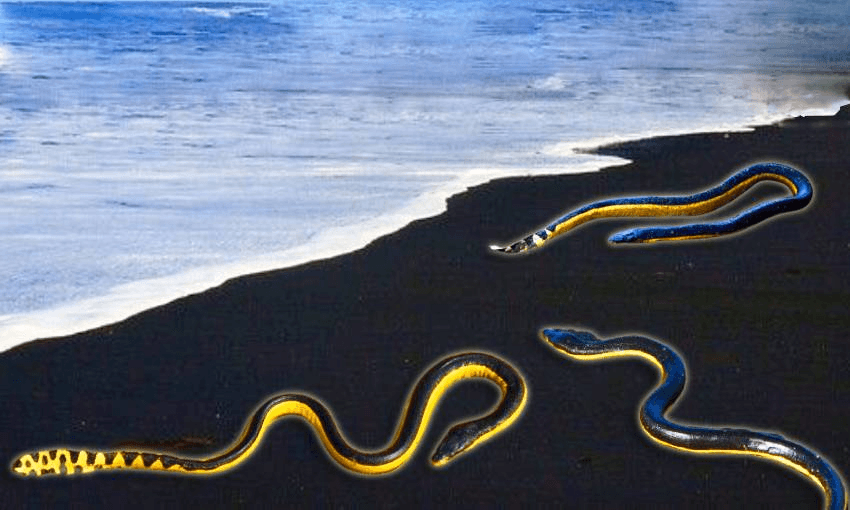New Zealand beaches have been visited by three yellow-bellied sea snakes in two weeks. Is this snakegeddon?
Our bird-based nation has been shaken to its core by the sightings of not one, not two, but three yellow-bellied sea snakes on our pristine beaches in the space of only two weeks. Two were found in Northland, but the third was found much further south, on the Manawatū coast. It was alive, but died as a local family drove it to Palmerston North.
All three were yellow-bellied sea snakes, the most commonly spotted snakes in New Zealand. Clinton Duffy, a marine technical advisor at DoC, explained that three snakes in two weeks is not unusual. According to the DoC website between six and 10 snakes reported each year, but Duffy admitted there are sometimes a few more than that. They show up mostly around Northland, but they’ve been spotted as far down as the Cook Strait. In 2016, three of these snakes washed up in Taranaki alone.
“I wouldn’t be worried about it,” he said.
DoC will cordon off an area containing a snake until nature takes its course. “Our staff aren’t supposed to touch them, but if they get brought in in a bucket or something we’ll deal with it.” DoC released the Tokerau snake in an isolated location. He would prefer people did not collect the snakes in buckets. “We recommend that everybody, including our own staff, steer clear of them.”
The snakes are extremely venomous and should not be handled. They’re unlikely to bite you, but if they do – you’re probably dead. There’s no anti-venom available in our country, as it has a short shelf life. “They’ve got tiny, rear-mounted fangs, so they have to get you in a really vulnerable part of the body, like the webbing between your finger and thumb,” said Duffy.
“I wouldn’t touch it, that’s for sure.”
There’s no record of anyone in New Zealand being bitten by a sea snake.
It’s not unusual for sea snakes to wash up in Northland, Tauranga, or Taranaki. The upper North Island is riddled with good deposit spots for warm ocean currents, which flow south from the tropical waters the snakes breed in and occasionally take one along for the ride.
The snakes are considered “native” under the Wildlife Act 1953 (because they get here on their own), so they come under the jurisdiction of the Department of Conservation. However, DoC does not employ any trained snake handlers.
Because they’re native, it’s illegal to kill or harass a sea snake. Just steer clear and call DoC. Yellow-bellied sea snakes spend their lives at sea, so one wriggling around on the sand is likely close to death; it’s injured or experiencing thermal shock in our colder temperatures.
The other snake species spotted in New Zealand waters is usually the rare banded sea krait (also known as the yellow-lipped sea krait, for its yellow lips). One lonely Saint Giron’s sea krait was identified in 1925, and has never been seen since. Both these species are extremely venomous.
The difference between sea kraits and sea snakes is that kraits wiggle on land to rest, digest, and reproduce. If you see a banded sea krait on land – they’re recognisable by their black-and-white bands and yellow mouth – it might not be dying. Exercise extreme caution.
Duffy said that while warming oceans could lead to yellow-bellied sea snakes developing a breeding population nearby, there’s little chance of us running into them. “They’re an oceanic species, so we wouldn’t be seeing them on land.” If we did, they’d be on their last legs.
Kraits are unlikely to move here in any significant numbers. “The kraits are really dependent on coral reefs,” he said. “They’re unlikely to establish any sort of population here in New Zealand.”
If you spot a snake, call DoC on 0800 362 468.

